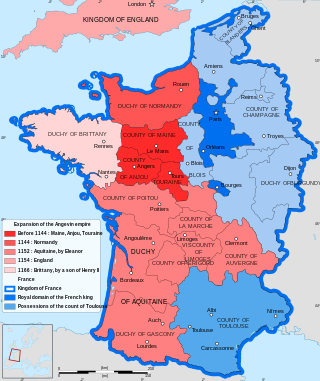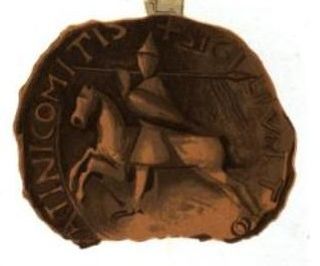
The duke of Aquitaine was the ruler of the medieval region of Aquitaine under the supremacy of Frankish, English, and later French kings.

Theobald the Great (1090–1152) was count of Blois and of Chartres as Theobald IV from 1102 and was Count of Champagne and of Brie as Theobald II from 1125. Theobald held Auxerre, Maligny, Ervy, Troyes and Châteauvillain as fiefs from Odo II, Duke of Burgundy.
Ebalus, or Ebles Manzer, or Manser, was Count of Poitou and Duke of Aquitaine on two occasions: from 890 to 892; and then from 902 until his death in 935 (Poitou) and from 928 until 932 (Aquitaine).
William III, called Towhead from the colour of his hair, was the "Count of the Duchy of Aquitaine" from 959 and Duke of Aquitaine from 962 to his death. He was also the Count of Poitou from 935 and Count of Auvergne from 950. The primary sources for his reign are Ademar of Chabannes, Dudo of Saint-Quentin, and William of Jumièges.

The Duchy of Aquitaine was a historical fiefdom located in the western, central and southern areas of present-day France, south of the river Loire. Although the full extent of the duchy, as well as its name, fluctuated greatly over the centuries and at times comprised much of what is now southwestern (Gascony) and central France.
Richard the Justiciar (858–921), also known as Richard of Autun, was count of Autun from 880 and the first margrave and duke of Burgundy. He attained suzerainty over all the counties of Burgundy save Mâcon and by 890 he was referred to as dux (duke) and by 900 as marchio (margrave). By 918 he was being called dux Burgundionem or dux Burgundiae, which probably signified less the existence of a unified Burgundian duchy than feudal suzerainty over a multiplicity of counties in a specific region.
Ranulf I (820–866) was a Count of Poitiers and Duke of Aquitaine. He is the son of Gerard, Count of Auvergne. Few details are known about Ranulf I, except that he died in 866 in Aquitaine from wounds received in the Battle of Brissarthe against the Vikings.

Boso was a Frankish nobleman of the Bosonid family who was related to the Carolingian dynasty and who rose to become King of Lower Burgundy and Provence.

Cluny Abbey is a former Benedictine monastery in Cluny, Saône-et-Loire, France. It was dedicated to Saints Peter and Paul.
The Cluniac Reforms were a series of changes within medieval monasticism in the Western Church focused on restoring the traditional monastic life, encouraging art, and caring for the poor. The movement began within the Benedictine order at Cluny Abbey, founded in 910 by William I, Duke of Aquitaine (875–918). The reforms were largely carried out by Saint Odo and spread throughout France, into England, and through much of Italy, northern Portugal and Spain.
Bernard II Tumapaler was Duke of Gascony from 1039 to 1052 and Count of Armagnac from 1020 to 1061.
Ermengarde or Ermengard or Ermingarde or Irmingard or Irmgard is a feminine given name of Germanic origin derived from the Germanic words "ermen/irmin," meaning "whole, universal" and "gard" meaning "enclosure, protection". Armgarð is a Faroese version. It is the name of various historical women:
Boso was a Burgundian nobleman who spent much of his career in Italy, where he became Margrave of Tuscany about 932. He ruled semi-autonomously and was a benefactor of the churches of his region. He lost his office in 936 and probably returned to Burgundy.
Ermengard of Italy was the queen of Provence as the spouse of King Boso. She was the second and only surviving child of Emperor Louis II. In her early life, she was betrothed to Constantine, the junior Byzantine emperor, but whether the marriage actually occurred or not is still debated among historians. In 871, Ermengard and her family were taken hostage by Adelchis of Benevento but were later freed. In 876, Ermengard married Boso, a nobleman with connections to the Carolingian dynasty, and became queen upon his accession to the throne of Provence in 879. After her husband's death in 887, she ruled the kingdom as regent during the minority of their son Louis the Blind.
Saint Berno of Cluny or Berno of Baume was the first abbot of Cluny from its foundation in 909 until he died in 927. He began the tradition of the Cluniac reforms which his successors spread across Europe.

Bernard Plantapilosa or Bernard II of Auvergne, or Plantevelue, son of Bernard of Septimania and Dhuoda, was the Count of Auvergne from 872 to his death. The Emperor Charles the Fat granted him the title of Margrave of Aquitaine in 885.
Frothar or Frotar was an Aquitanian prelate in West Francia, who held two different bishoprics and three abbacies during a long career. He was appointed Archbishop of Bordeaux around 859, but Viking raids forced him to abandon his seat in 870. With papal approval, he was transferred to the Archdiocese of Bourges in 876. He died after 893.
Engelberga of Provence, Duchess of Aquitaine was a 8th-9th century Bosonid noblewoman.






